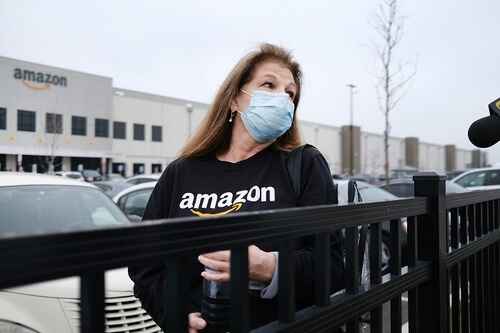Update, Aug. 28: Despite pushback from employees, Amazon CEO Andy Jassy told employees during a recent meeting that, if they fail to comply with the return-to-office policy, it’s “not going to work out for you,” Business Insider reports, citing a copy of a recording of the meeting.
It’s the latest sign that employers across industries are increasingly bullish on returning workers to offices, with about three-quarters of organizations requiring at least some time in the office each week, according to recent data.
Amazon’s policy preceded an updated RTO policy by Meta in August, in which employees could be terminated for failing to abide by the company’s in-office attendance requirements. Meta (Facebook), Amazon, Apple, and Alphabet (Google)—four of the five major tech companies formerly known as FAANG)—are linking office attendance with either performance reviews or termination.
Original story: As more employers roll out return-to-office policies, a new strategy from Amazon is making waves.
Amazon recently issued a return-to-office policy that calls for corporate employees to work for three days a week from one of its centrally assigned hub locations, located in large, urban centers—or take a voluntary resignation with no severance pay, according to a report in Business Insider.
Amazon’s approach may offer some unique benefits for employers navigating the challenges of getting workers back to the office, says Scott Herndon, an employment attorney in Berkeley, Calif. By defining non-compliance as a voluntary resignation and offering no severance pay, employers don’t have to pay out unemployment insurance, says Herndon, who represents employees in legal workplace matters.
“This may help companies save money in the long run,” he says, compared to firing employees for non-compliance with a return-to-office policy.
Additionally, Herndon notes that a “voluntary resignation” approach to RTO can help employers sidestep their own policies for progressive disciplinary action in the event of non-compliance, which, in turn, can save HR time.
Placing the onus on employees also clearly informs them of the consequences of not complying with the policy, providing the company legal shelter, he adds.
Amazon moves to hub policy
Amazon’s return-to-hub policy is expected to have a particular impact on employees who moved after the company went remote during the pandemic and those who were hired on a remote basis. Under the strategy, U.S.-based employees who live far from a hub and don’t want to relocate closer have three options, reports Business Insider.
One requires approval from an Amazon director or HR partner for a co-location exception, which would allow them to work from their current location but continue to come into an Amazon office—not necessarily one of the urban hubs—three times a week, according to Business Insider, which viewed the guidelines.
Another option is to seek employment elsewhere within the company, within six months, on a team that can accommodate their location needs. Otherwise, if any employee is not willing to relocate, the last option is to leave the company voluntarily without severance.
Because Amazon’s return-to-hub policy applies to virtually all corporate employees across the board, it will make it difficult for employees to file a lawsuit against Amazon for discrimination or impartial treatment, Herndon says.
Amazon joins the RTO enforcement movement
Amazon’s actions mark the latest effort by employers to use enforcement measures to get employees to comply with return-to-office policies. These enforcement policies have ranged from linking in-office attendance to performance reviews to firing workers for non-compliance.
To help its employees understand the new return-to-hub policy, Amazon provided managers with a list of talking points, best practices and even Q&A templates, reports Business Insider.
Some of the guidance included leading conversations with empathy, compassion, clarity and directness, as well as preparing what to say ahead of time.
Whether this preparation will be effective in stemming employee dissatisfaction is yet to be seen. Earlier this year, Amazon employees staged a lunchtime walk-out to protest the company’s return-to-office policy.
It’s a move that echoes wider pushback from employees about post-pandemic RTO mandates.
In the past 18 months, Herndon notes, the number of people calling his firm to inquire about legally contesting their employers’ return-to-office policy has skyrocketed by 40%-50%.
And in the past six months, those calls have shifted from focusing on what an employer can require them to do as an individual to the legalities of broader, RTO policies, Herndon says.
“A critical question for HR is whether to consider implementing it across the workforce. If policies are unevenly applied, that raises the question of legality,” Herndon says. “The job of HR is to be aware of the consequences and prepare for them.”



